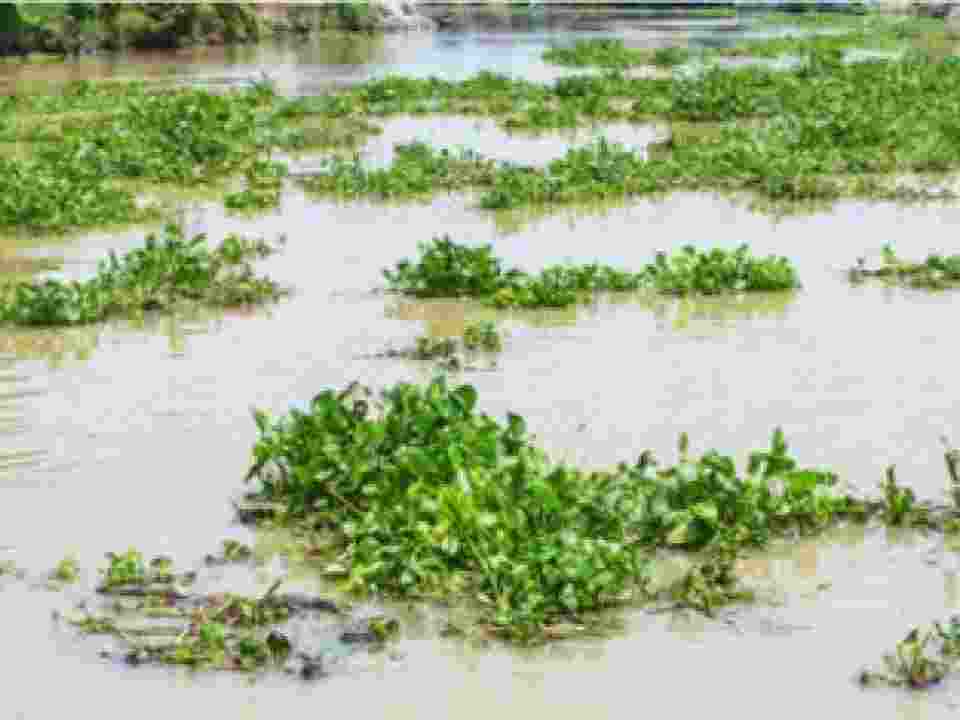Description
A vast layer of water hyacinth has engulfed the Mula River near Holkar Bridge, raising environmental concerns among local residents. The dense growth of this invasive aquatic plant is significantly impacting the river’s ecological balance, water quality, and flow. Experts warn that the unchecked spread of water hyacinth can lead to severe environmental and economic consequences.
Understanding Water Hyacinth: An Invasive Aquatic Plant
Scientific Classification & Origin
Scientific Name: Eichhornia crassipes
Family: Pickerelweed (Pontederiaceae)
Native Region: Originally from tropical regions of South America
Current Distribution: Found across Asia, Africa, North America, and Europe, except for Antarctica
Mode of Spread: Propagates rapidly through stolons (runners) and seeds, allowing it to establish colonies in water bodies at an alarming rate
Water Hyacinth A Problem
Water hyacinth is classified as one of the most destructive aquatic weeds globally due to its rapid growth and ability to choke water bodies. It negatively impacts ecosystems, fisheries, and human activities.
Harmful Effects Of Water Hyacinth
Blocks Sunlight & Oxygen Supply:
Forms thick, impenetrable mats that prevent sunlight from reaching native aquatic plants, disrupting photosynthesis.
Reduces oxygen levels, leading to the death of fish and other aquatic organisms.
Disrupts Water Flow & Navigation:
Causes stagnation in water bodies, leading to reduced water flow.
Impedes boats and traditional water transportation in affected rivers and lakes.
Threatens Local Biodiversity:
Outcompetes native aquatic plants, altering the ecosystem.
Provides breeding grounds for mosquitoes, increasing the risk of vector-borne diseases like malaria and dengue.
Reduces Water Quality:
Traps sediments and organic matter, leading to the accumulation of pollutants and the deterioration of water quality.
Absorbs heavy metals and toxins, sometimes making the water unsafe for consumption and agriculture.
Blocks Irrigation & Hydroelectric Systems:
Clogs irrigation channels, drainage systems, and dams, affecting agricultural productivity.
Reduces the efficiency of hydroelectric power plants by obstructing turbines and intake pipes.
Historical Introduction Of Water Hyacinth In India
Water hyacinth was introduced in India during British colonial rule as an ornamental plant due to its striking lavender-violet flowers. However, without natural predators to control its growth, the plant quickly spread across rivers, lakes, and reservoirs, turning into an invasive species that threatened local ecosystems.
Potential Uses Of Water Hyacinth
Despite its reputation as a nuisance plant, water hyacinth has several beneficial applications, if managed correctly.
Biofertilizer & Organic Farming
The plant is rich in nitrogen, phosphorus, and potassium, making it an excellent biofertilizer for organic agriculture.
Decomposed water hyacinth is used as compost to improve soil fertility.
Handicrafts & Commercial Products
Its fibrous stems are processed into eco-friendly products like: Handbags, baskets, mats, and furniture, Interior décor items (such as lampshades and wallpapers)
Rural communities have started using water hyacinth as a raw material for small-scale industries.
Water Purification & Phytoremediation
Water hyacinth is known for its ability to absorb toxic metals and organic pollutants from water, helping in wastewater treatment.
Research has shown its potential in removing arsenic, lead, cadmium, and other heavy metals from polluted water bodies.
Biofuel & Energy Production
Water hyacinth is being explored as a potential source of bioethanol and biogas, which could contribute to renewable energy production.
Some regions have started using it for biomass energy generation.
Water Hyacinth Infestation
Given its rapid growth, controlling water hyacinth requires a multi-pronged approach involving physical, biological, and chemical methods.
Mechanical & Manual Removal
Harvesting Machines & Booms: Used to collect and remove large floating mats from water bodies.
Manual Extraction: Local communities can manually extract hyacinth to create biofertilizer and commercial products.
Biological Control Methods
Insect Predators: Introducing natural enemies like the weevil species Neochetina eichhorniae and Neochetina bruchi, which feed on hyacinth leaves and weaken its growth.
Herbivorous Fish: Some fish species like grass carp are known to feed on water hyacinth, helping to control its spread.
Chemical Control (With Caution)
Herbicides such as glyphosate, diquat, and 2,4-D have been used to kill water hyacinth, but excessive use can harm aquatic life and water quality.
Eco-friendly bio-herbicides are being explored as safer alternatives.
Sustainable Utilization Strategies
Encouraging the commercial use of water hyacinth for bioenergy, handicrafts, and wastewater treatment.
Promoting community-based projects where local populations can turn the weed into a resource instead of a liability.
Welcome to Notopedia.com, your free learning platform that caters to the diverse needs of students and aspirants across a spectrum of entrance exams and educational endeavors. Whether you're preparing for highly anticipated exams like CAT 2023, NEET 2023, JEE Main, or bank job vacancies, our platform offers a wealth of resources to guide you towards success. Stay up-to-date with the latest exam dates, announcements, and results for various government recruitment exams, including SSC CGL, CHSL, NDA, and UPSC. Explore comprehensive study materials, sample papers, and exam patterns to hone your skills and boost your confidence. From important dates like CBSE Class 10 and 12 date sheets to exam-specific information like JEE Main 2023 application form date, we cover it all. Notopedia.com is your go-to source for everything from admissions and admit cards to scholarships and college information. Whether you're aiming for a career in defense, government, banking, or higher education, our free learning platform equips you with the knowledge and resources you need to excel. Join us in your educational journey and unlock a world of opportunities, guidance, and comprehensive support.
For more Updates and Information - Visit Notopedia's Bulletin Board
For Latest Sarkari Jobs - Visit Notopedia's Sarkari Jobs Section
For access to more than 20,000 Colleges - Visit Notopedia's College Section
For School Studies and Exams Preparation across 14 Boards - Visit Notopedia's School Section
For Comprehensive Preparation of Sarkari Job Exams - Visit Notopedia's Sarkari Exams Section










